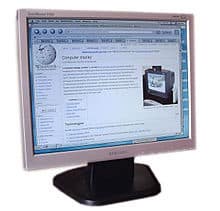Although it is reassuring to know that the experts at Boxer Wachler Vision Institute are available to assist you following an ocular crisis, your best course of action is to try to avoid eye emergencies in the first place. To protect the health of your eyes, Dr. Brian suggests re-examining some of these common bad habits: Read more
Category: Blog
Common Misconceptions about Keratoconus
Keratoconus is a disorder that causes the cornea to bulge out into a cone-like shape and leads to blurry, distorted vision. Although the affliction occurs often enough to keep Dr. Brian busy with keratoconus patients, it is still rare enough that the general population does not have a firm understanding of what keratoconus is.
Allow Dr. Brian to correct some of the misinformation about this condition: Read more
Benefits of Fortified LASIK®
LASIK is a very safe procedure. However, some prospective patients are concerned about potential complications of refractive surgery, and opt out entirely. That is understandable — your vision is nothing to mess around with! Fortunately, Dr. Brian has developed Fortified LASIK, a form of the procedure that is even safer, in turn giving patients the confidence to finally pull the trigger.
Benefits of Fortified LASIK include: Read more
7 Things You Could Do To Avoid Eye Strain At Your Desk Job
1. Sitting too close to your computer screen, Obvious right?

We do this without realizing it, but staring at a screen so close can result in eye fatigue, dryness and blurry vision. Staring closely at the screen, tires out our ciliary muscle which controls the eye lens to focus.
2. Out with the old in with the new!

Glasses that is, old prescription glasses are harmful. Getting custom computer glasses give your eyes the greatest lens power and a clear wide field view, eliminating any excessive focusing effort.
3. Not the brightest bulb in the box

Excessive overhead lighting is not needed while on the computer. Lighting should not be any brighter than your screen. Make sure contrast controls and brightness are properly adjusted on your monitor.
4. Sit up tall

Eye level should be at the top of your monitor, Hips and back should go as far back as they can go in the chair feeling fully supported. Moving forward to the edge of the computer chair while aligning your back will also ease back muscles.
5. High resolution flat panel screen

Old monitors are low resolution and cause strain on the eye, upgrading to a newer one will cause less eye fatigue. The monitor should not be tilted put position in front of ones face.
6. The closer the mouse the better

Having the mouse close to your reach keeps you from leaning forward and closer to the screen. Viewing distance should be an arms- length away, and the keyboard should be placed so your arms hang vertically.
7. Its OK to blink

Blinking relieves your eyes cleaning it out and flushes fresh tears. Set aside some time to do a couple of blinking exercises by blinking ten times into each direction. For more effective results, your eyes should be relaxed while closing. Avoid tight lid squeeze.
Alleviate Dry Eyes During The Fall

As the leaves change colors and fall quickly approaches, the air gets drier causing the eyes to dry out. Dry eyes is a common condition that is suffered by many people around the world. One of the main causes of Dry Eye is Meibomian Gland Dysfunction. Meibomian gland dysfunction causes a blockage of your meibomian gland, and causes inflammation causing discomfort, and irritability in the eye.Tear-flow imbalance, age, side effects from certain medicine can also be common reasons for dry eyes.
For those who have chronic dry eyes there are many treatments available to help you to reduce symptoms, even in some cases fix the problem.
Below are a few treatment options available and symptoms of dry eyes.
Symptoms
- Reddening of the eyes
- Irritation
- Increased rubbing
- Burning sensations
- Stinging
- Watering
- Foreign body sensation
- Excessive blinking
- Excessive eye rubbing
Treatments for Dry Eyes:
Artificial Tears & Eye Drops
There are several over the counter drops or artificial tears that will allow you temporary relief from dry eyes. This solution is only a temporary fix. Being evaluated to find the underlining cause of your dry eyes is very important.
Temporary Punctual Occlusion
This also a temporary fix if the ducts in the eye are draining too much the plugs can close the ducts to allow some relief. It is also used to determine if this would be a good permanent fix for your dry eye condition. If so than permanent plugs can be added or non-dissolving punctual occlusion.
LipiFlow
Lipiflow, which is an FDA approved treatment is a non-invasive, 12 minute spa-like treatment that cleans out the clogged oil glands using heat.Most patients describe the procedure as a “mini- facial” for the eyelids.
9 Brain Foods to Power You Through The Day
Breakfast is the most important meal of the day. Studies have shown that fueling the brain in the morning helps you think, act and learn. Being alert and awake in the morning can often be difficult without a little boost, but incorporating these foods in your diet with give you the brain power and nutrients to do just that.
1. Whole Grains

Whole grains release glucose into the bloodstream keeping you mentally alert throughout the day. Brown cereals, and grainy bread supply energy as well. The benefits of fiber, vitamins and minerals help improve your overall health.
2. Blueberries

Consumption of this antioxidant filled fruit is essential for improving memory and brain function. Studies have showed that the antioxidants in the berries interact with aging neurons improving cell signaling.
3. Caffeine

This antioxidant helps fight inflammation that can lead to many chronic conditions, arthritis and certain cancers. Caffeine also helps with concentration and memory. It boosts short-term memory.
4. Spinach

Green leafy vegetables are loaded with lots of nutrients that help skin, hair, iron, and provide protein. There has been studies that suggest this low calorie vegetable have a lower rate of cognitive decline compared who those who ate less.
5. Avocados

This fiber filled food has multiple benefits, improving vascular health and blood flow. Avocado is a high fat food, containing oleic acid that reduces inflammation and benefits effects on genes linked to cancer.
6. Beets

Beets are useful in blood flow to the brain. The naturally- occurring nitrates and potassium help the nerve and muscle function. Beets also contain high amounts of anti-inflammatory agents.
7. Dark Chocolate
 Dark chocolate has caffeine content that is antioxidant rich. It contains flavonoids, a class of antioxidant that helps boost blood flow, brain health and regulating cholesterol and blood pressure.
Dark chocolate has caffeine content that is antioxidant rich. It contains flavonoids, a class of antioxidant that helps boost blood flow, brain health and regulating cholesterol and blood pressure.
8. Garlic

Not only does garlic boost immune system and control cholesterol, the organosulfar compound diminishes glioblastoma cells which is a type of tumor cell.
9. Lentils

This legume is high in protein, fiber and vitamin B. Folate decreases levels of amino acids that may impair brain functioning. Lentils also carry oxygen throughout your body which increases energy production and metabolism.
Back To School Eye Care Tips for Kids
 With kids busy running to class, staring endlessly at computer screens, studying or training hard for their school’s athletics program, thinking about maintaining good eye health and safety may not be a top priority in their minds. By taking the time to teach them a few important safety tips, parents can ensure their kids will be able to focus on what really matters: education.Below are a few of the most important things to remember:
With kids busy running to class, staring endlessly at computer screens, studying or training hard for their school’s athletics program, thinking about maintaining good eye health and safety may not be a top priority in their minds. By taking the time to teach them a few important safety tips, parents can ensure their kids will be able to focus on what really matters: education.Below are a few of the most important things to remember:1. Get your child an eye exam before school starts: Problems with your children’s vision can be detected through a routine eye exam. It’s important to correct these issues, such as nearsightedness or farsightedness before they create more serious complications such as difficulty learning or the development of recurrent headaches.
2. Kids should wash their hands regularly: According to a study published in the American Journal of Infection Control, more than 164 million school days are missed due to the spread of infectious diseases. Three million of those missed days are the direct result of acute conjunctivitis, also known as pink eye. It’s important to remind your children to wash their hands regularly and avoid touching their eyes as much as possible.
3. Ensure children wear protective eyewear when playing sports: Most eye injuries among kids aged 11 to 14 occur while playing sports, with nearly 35,000 incidents per year according to the National Eye Institute. Protective eyewear, such as goggles or a helmet-mounted eye/face shield, can drastically reduce the risk of serious eye injury. As parents, a great way to help is by setting a good example whenever you participate in sports.
4. Encourage kids to give their eyes a rest: With the school year in full swing, your children will likely be spending a lot of time with their nose stuck in books or staring at the computer screen. Over time, this can cause eye strain, headaches, blurred vision or even nearsightedness. Remind your children to give their eyes a rest every 20 to 30 minutes. It’s a good idea to minimize glare where they are working, as this can force the eyes to work harder than need be.
5. Purchase your children high E-SPF glasses: A lot of activities that kids participate in after school exposes them to the sun’s harmful UV rays. Over time, UV exposure can lead to a host of problems for the eyes, including the early development of cataracts. By purchasing protective, high E-SPF prescription glasses or sunglasses for your child, you’ll foster and encourage their good eye health years to come.
If at any time you suspect your child may be having vision issues, please consult your family eye doctor.
6 Foods That Contain Vitamins For Your Eyes
Below is a list of Green Lutein filled food known for protecting eye health. Next time you are at the grocery store remember to incorporate these into your diet!
1. Kale
1 cup raw
Kale is beneficial to prevent cataracts and macular degeneration. Kale contains lutein and zeaxanthin which strengthen the retina. Out of all 20 carotenoids (plant pigments) found in the human blood zeaxanthin and lutein is found in the visual system, reducing glare and enhancing contrast.
2. Turnip Greens

½ cup cooked
Turnip greens provide antioxidant and protective light- filtering functions. They are a part of the cruciferous vegetable family containing lutein and zeaxanthin. Turnip greens are also a preventative against mascular degeneration and cataracts.
3. Collard Greens

½ cup cooked
Collard Greens is an excellent source of lutein and antioxidants. This green is loaded with vitamin A, that helps fight dry eyes, damaged night vision and degeneration of your eyes.
4. Spinach

1 cup raw
Protects the eyes from age related macular degeneration and cataracts stored in the macula. The macula is part of the retina that blocks the eye from harmful light. The lutein and zeaxanthin absorb blue light.
5. Broccoli

1 cup cooked
Repair eyes from radiation, aids with macular degeneration and cataract prevention. 1 cup of broccoli is equivalent to 2,015 micrograms, lutein and zeaxanthin per serving. Vitamin B2 is a top source for riboflavin contained in broccoli also which helps your eyes adjust to light changes.
6. Brussels Sprouts

1 cup cooked
Filters our harmful blue light rays increases protection against UV light damage. Brussel sprouts also contain vitamin A which supports mucosa skin and eye health. They also help aid in retinal damage, macular degeneration and age- related macular degeneration.
Why Do I Have Dark Circles Under My Eyes?
 Most women can agree that having dark circles under their eyes is one of their main beauty insecurities. It’s no secret the “panda eyes” do not just come from lack of sleep. Diet, sun exposure, allergies, heredity, contact dermatitis, eczema and thinning of the skin related are all common causes of dark under eye circles. Being sleep deprived is the most common cause and can be simple to prevent, however oversleeping can cause dark eye circles as well. If the dark circles appeared in early childhood, one can assume it is an inherited trait that some people may or may not grow out of. Nasal congestion from allergies dilates the blood vessels around the eyes making the circles more apparent. Iron deficiency can also stop blood circulation to carry oxygen into the eye tissues. Excessive drinking and smoking is also a main contributor. Since alcohol dehydrates the body, after a night of heavy drinking it is important to drink lots of water and apply moisturizer to the under eye area. Controlling the amount of sodium your body intakes will also help with under eye circles because salt causes fluid retention in the body as well as the eye area.
Most women can agree that having dark circles under their eyes is one of their main beauty insecurities. It’s no secret the “panda eyes” do not just come from lack of sleep. Diet, sun exposure, allergies, heredity, contact dermatitis, eczema and thinning of the skin related are all common causes of dark under eye circles. Being sleep deprived is the most common cause and can be simple to prevent, however oversleeping can cause dark eye circles as well. If the dark circles appeared in early childhood, one can assume it is an inherited trait that some people may or may not grow out of. Nasal congestion from allergies dilates the blood vessels around the eyes making the circles more apparent. Iron deficiency can also stop blood circulation to carry oxygen into the eye tissues. Excessive drinking and smoking is also a main contributor. Since alcohol dehydrates the body, after a night of heavy drinking it is important to drink lots of water and apply moisturizer to the under eye area. Controlling the amount of sodium your body intakes will also help with under eye circles because salt causes fluid retention in the body as well as the eye area.
One should seek medical attention in rare cases like hypothyroidism which is a disorder that does not let the thyroid gland produce enough thyroid hormone, liver disease and Trichinosis, a disease caused by parasite worms.
- Do not exceed frequent sun exposure
- Cold eye compresses: any frozen item with a soft cloth around it can be applied o the eyes
- Make sure you are getting plenty of sleep. Lack of sleep leaves dark ugly circles making one look “hollow-eyed”
- Concealer: For a temporary alternative, makeup application can lessen the dark rings around your eyes
 Besides the four listed items above, there are many helpful remedies you can try at home. I provided you with a list below.
Besides the four listed items above, there are many helpful remedies you can try at home. I provided you with a list below.
- Cucumbers and Potatoes: thinly slicing some and apply to the eyes for 15 min
- Tea bags: freeze or refrigerate tea bags and apply to the eyes
- Almond oil: massage a small amount to the under eyes and leave overnight
- Lemon juice: squeeze lemon juice on a cotton ball and apply to under eye area
- Mint: make a paste combining tomato juice and mint leaves, apply to the under eyes
- Yoga: relaxing the body and mind will help you feel more rested
- Water: consume plenty of water to keep your skin glowing
- Coffee beans and Honey: ground coffee and honey to make a paste, apply to under eye area
- Baking soda: apply baking soda to hot water making a paste and apply to under eye area
- Aloe Vera: apply gel to under eye area to help reduce inflammation
7 Healthy Foods Beyond Carrots for Healthy Eyes
You have likely heard of degenerative diseases such as cataracts, keratoconus and macular degeneration. For preventative measures, I am sure you know salmon is good for your heart and oatmeal for your cholesterol, but did you know that certain foods (other than carrots) can also improve your eye health? According to a studyby the National Eye Institute, foods high in antioxidants such as omega-3 fatty acids, glutathione, zinc and vitamins C and E may reduce the risk of certain diseases.
Here are 7 healthy foods that healthy eyes crave:
- Seafood: Fish contains some of the highest levels of quality omega-3 essential fatty acids, in addition to being very tasty! Including omega-3 fatty acids in your diet can support proper visual development and retinal function over time. If you don’t like the taste of fish, raw almonds are a great alternative to incorporate omega-3s into your diet.
- Orange and Grapefruit Juice: In addition to fighting immune system deficiencies, cardiovascular disease, prenatal health problems and skin wrinkling, Vitamin C has been shown to help lower the risk of cataracts and age-related macular degeneration. One cup of orange juice packs 124 milligrams of vitamin C and grapefruit juice has 94 milligrams.
- Eggs: If there is one universal nutritional factor for eye health, it’s glutathione — a natural antioxidant. Glutathione has been shown to help prevent cataracts, glaucoma, retinal disease and diabetic blindness. Eggs are a great natural source, but if you can’t stomach them, look to get your Glutathione from vitamins.
- Oysters: Oysters, poultry, milk, shellfish, baked beans and whole grains are great sources of zinc. Lack of zinc can lead to cataracts or night vision, a condition associated with blurred vision, halos and night blindness.
- Kale: This leafy vegetable is one of the healthiest foods for your body, including your eyes. Kale has high levels of Vitamin E, which can protect your eyes from damage caused by free radicals. Free radicals are unstable molecules which break down healthy tissue in the body. Kale is easy to add to smoothies for a nutritional boost or can be used as a side salad with any meal! My kids love “kale chips,” which my wife and I make by lightly baking them in the oven.
- Pork: An often overlooked yet equally important nutrient for your eye health is zinc. Pork meat has high levels of zinc, which plays a key role in bringing Vitamin A from the liver to the retina in order to produce melanin — a protective pigment in the eyes. If you do not eat pork or are a vegetarian, chicken and cashews are excellent alternatives. Now you have a good excuse to indulge in BBQ ribs!
- Camu camu: This Brazilian superfruit is a newcomer to the American market, and it packs the highest vitamin C content of any fruit on the planet. Vitamin C plays a key role in lowering your risk for developing cataracts and can slow the progression of age-related macular degeneration while protecting against visual acuity loss.






